JEEP WRANGLER 2013 JK / 3.G Service Manual
Manufacturer: JEEP, Model Year: 2013, Model line: WRANGLER, Model: JEEP WRANGLER 2013 JK / 3.GPages: 666, PDF Size: 5.16 MB
Page 41 of 666

NOTE:The ignition key that is used to start the vehicle
is used to lock or unlock the doors, swing gate, glove
compartment, and console storage.
WARNING!
• For personal security reasons and safety in a colli-
sion, lock the vehicle doors when you drive, as well
as when you park and leave the vehicle.
• When leaving the vehicle, always remove the Key
Fob from the ignition and lock your vehicle.
• Never leave children alone in a vehicle, or with
access to an unlocked vehicle.
• Allowing children to be in a vehicle unattended is
dangerous for a number of reasons. A child or
others could be seriously or fatally injured. Chil-
dren should be warned not to touch the parking
brake, brake pedal or the shift lever.
• Do not leave the key in or near the vehicle , or in a
location accessible to children. A child could oper-
ate power windows, other controls, or move the
vehicle.
Manual Door Lock (Half Doors)
2
THINGS TO KNOW BEFORE STARTING YOUR VEHICLE 39
Page 42 of 666
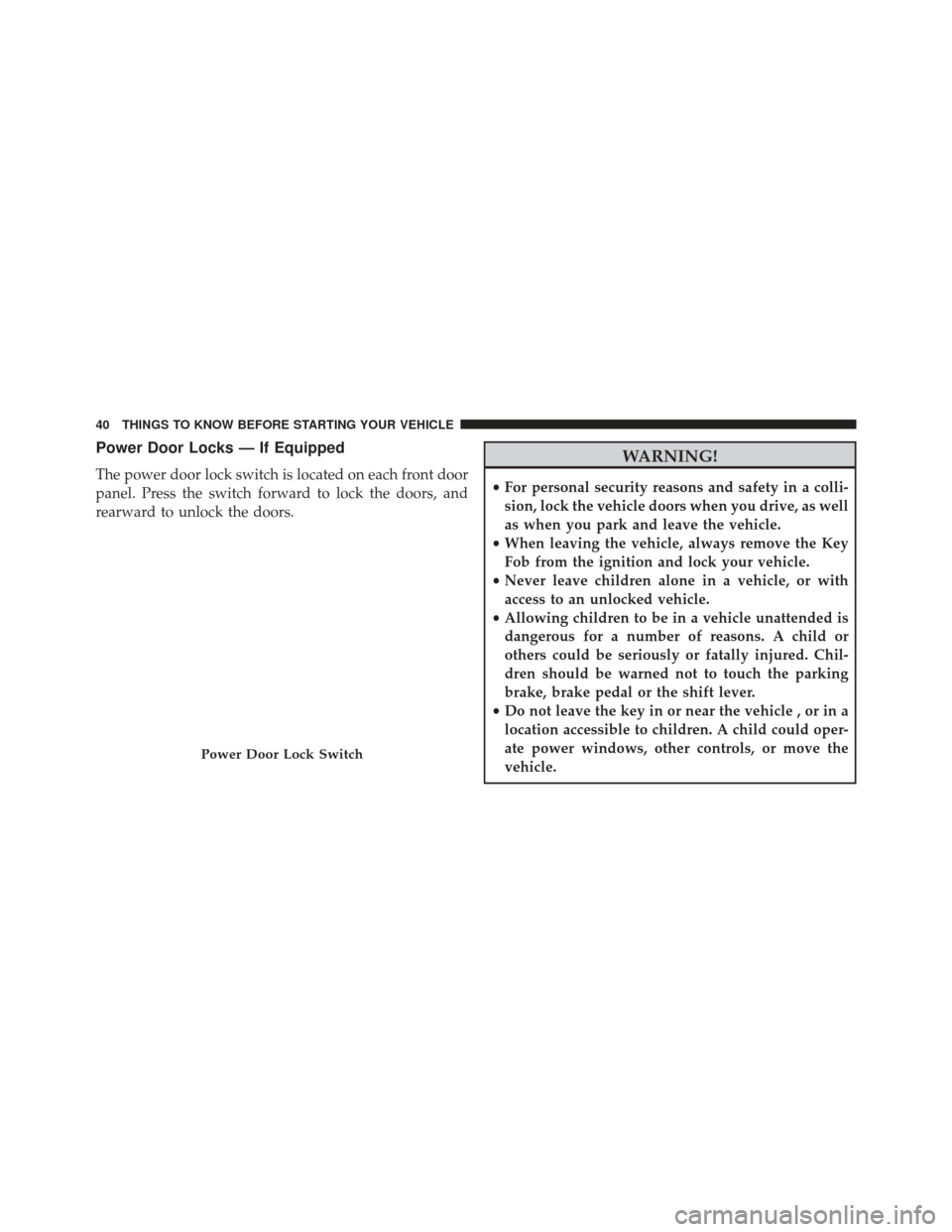
Power Door Locks — If Equipped
The power door lock switch is located on each front door
panel. Press the switch forward to lock the doors, and
rearward to unlock the doors.
WARNING!
•For personal security reasons and safety in a colli-
sion, lock the vehicle doors when you drive, as well
as when you park and leave the vehicle.
• When leaving the vehicle, always remove the Key
Fob from the ignition and lock your vehicle.
• Never leave children alone in a vehicle, or with
access to an unlocked vehicle.
• Allowing children to be in a vehicle unattended is
dangerous for a number of reasons. A child or
others could be seriously or fatally injured. Chil-
dren should be warned not to touch the parking
brake, brake pedal or the shift lever.
• Do not leave the key in or near the vehicle , or in a
location accessible to children. A child could oper-
ate power windows, other controls, or move the
vehicle.
Power Door Lock Switch
40 THINGS TO KNOW BEFORE STARTING YOUR VEHICLE
Page 43 of 666

Automatic Door Locks — If Equipped
The auto door lock feature default condition is enabled.
When enabled, the door locks will lock automatically
when the vehicle’s speed exceeds 15 mph (24 km/h). The
auto door lock feature can be enabled or disabled by your
authorized dealer per written request of the customer.
Please see your authorized dealer for service.
Automatic Unlock Doors On Exit
The doors will unlock automatically on vehicles with
power door locks if:
1. The “Automatic Unlock Doors On Exit” feature isenabled.
2. The vehicle speed returned to 0 mph (0 km/h) and the transmission shift lever is in NEUTRAL or PARK.
3. The driver door is opened.
4. The doors were not previously unlocked.
Automatic Unlock Doors On Exit Programming
The “Automatic Unlock Doors On Exit” feature can be
enabled or disabled as follows:
1. Close all doors and place the key in the ignition.
2. Cycle the ignition switch between LOCK and ON/ RUN and then back to LOCK four times ending up in
the LOCK position.
3. Press the power door unlock switch to unlock the doors.
4. A single chime will indicate the completion of the programming.
5. Repeat these steps if you want to return this feature to its previous setting.
NOTE: Use the “Automatic Unlock Doors On Exit”
feature in accordance with local laws.
2
THINGS TO KNOW BEFORE STARTING YOUR VEHICLE 41
Page 44 of 666

Child-Protection Door Lock System — Rear
Doors
To provide a safer environment for small children riding in
the rear seats, the rear doors are equipped with Child-
Protection Door Lock system.
To Engage Or Disengage The Child-Protection
Door Lock System
1. Open the rear door.
2. Insert the tip of the ignition key into the lock androtate to the LOCK or UNLOCK position.
3. Repeat steps 1 and 2 for the opposite rear door.
WARNING!
Avoid trapping anyone in a vehicle in a collision.
Remember that the rear doors can only be opened
from the outside when the Child-Protection locks are
engaged.
Child-Protection Door Lock Function
42 THINGS TO KNOW BEFORE STARTING YOUR VEHICLE
Page 45 of 666
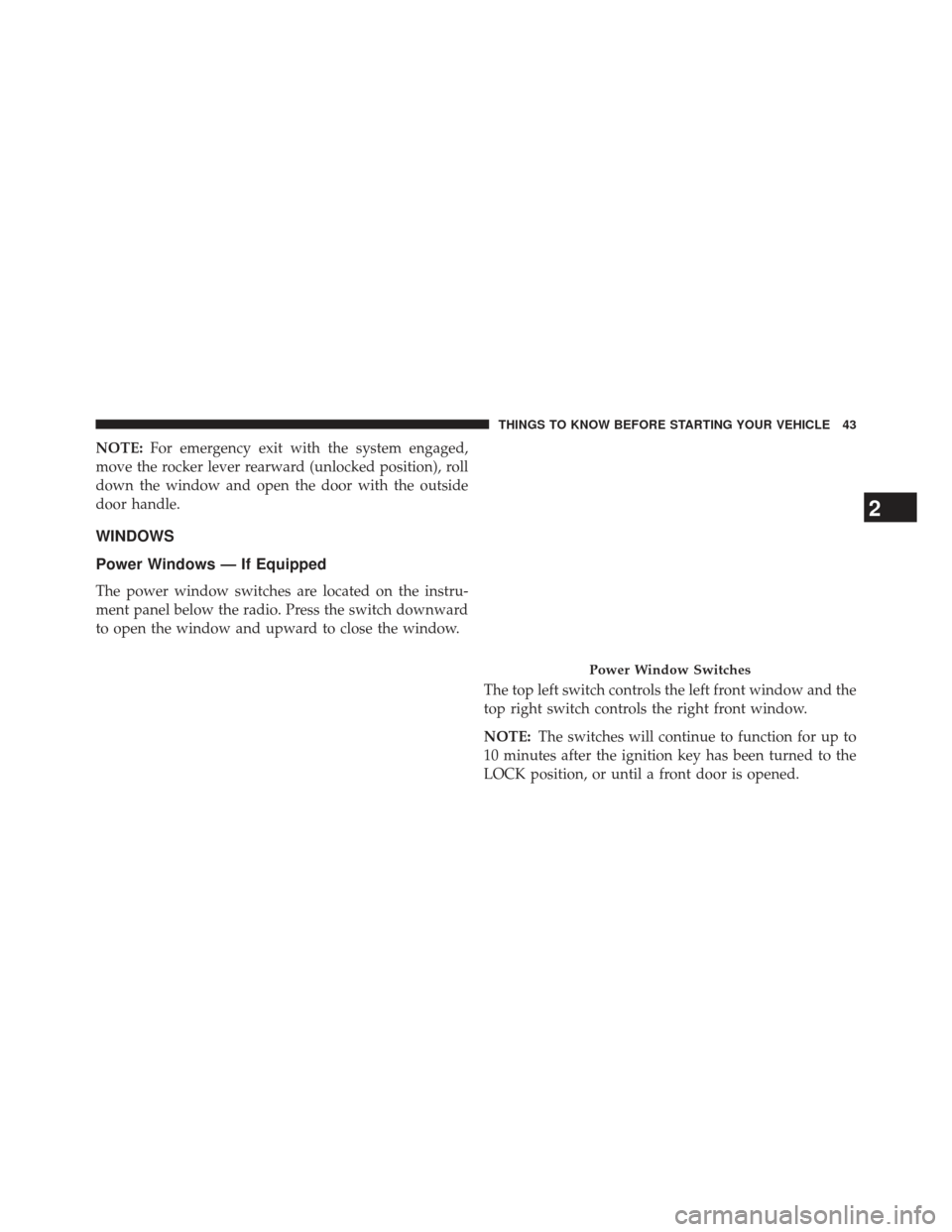
NOTE:For emergency exit with the system engaged,
move the rocker lever rearward (unlocked position), roll
down the window and open the door with the outside
door handle.
WINDOWS
Power Windows — If Equipped
The power window switches are located on the instru-
ment panel below the radio. Press the switch downward
to open the window and upward to close the window.
The top left switch controls the left front window and the
top right switch controls the right front window.
NOTE:The switches will continue to function for up to
10 minutes after the ignition key has been turned to the
LOCK position, or until a front door is opened.
Power Window Switches
2
THINGS TO KNOW BEFORE STARTING YOUR VEHICLE 43
Page 46 of 666

Four-Door Models
The lower left switch controls the left rear passenger
window, and the lower right switch controls the right
rear passenger window.
Auto-Down
Both the driver and front passenger window switches
have an “Auto-Down” feature. Press the window switch
past the first detent, release, and the window will go
down automatically. To cancel the Auto-Down move-
ment, operate the switch in either the up or down
direction and release the switch.
To stop the window from going all the way down during
the Auto-Down operation, pull up on the switch briefly.
To partially open the window, press halfway to the first
detent and release it when you want the window to stop.
Window Lockout Switch — Four-Door Models
The window lockout switch (located between the front
window switches) allows you to disable the rear window
switches that are located on the back of the center floor
console. To disable the window controls, press the win-
dow lockout button downward. To enable the window
controls, press the window lockout button upward.
Window Lockout Switch
44 THINGS TO KNOW BEFORE STARTING YOUR VEHICLE
Page 47 of 666
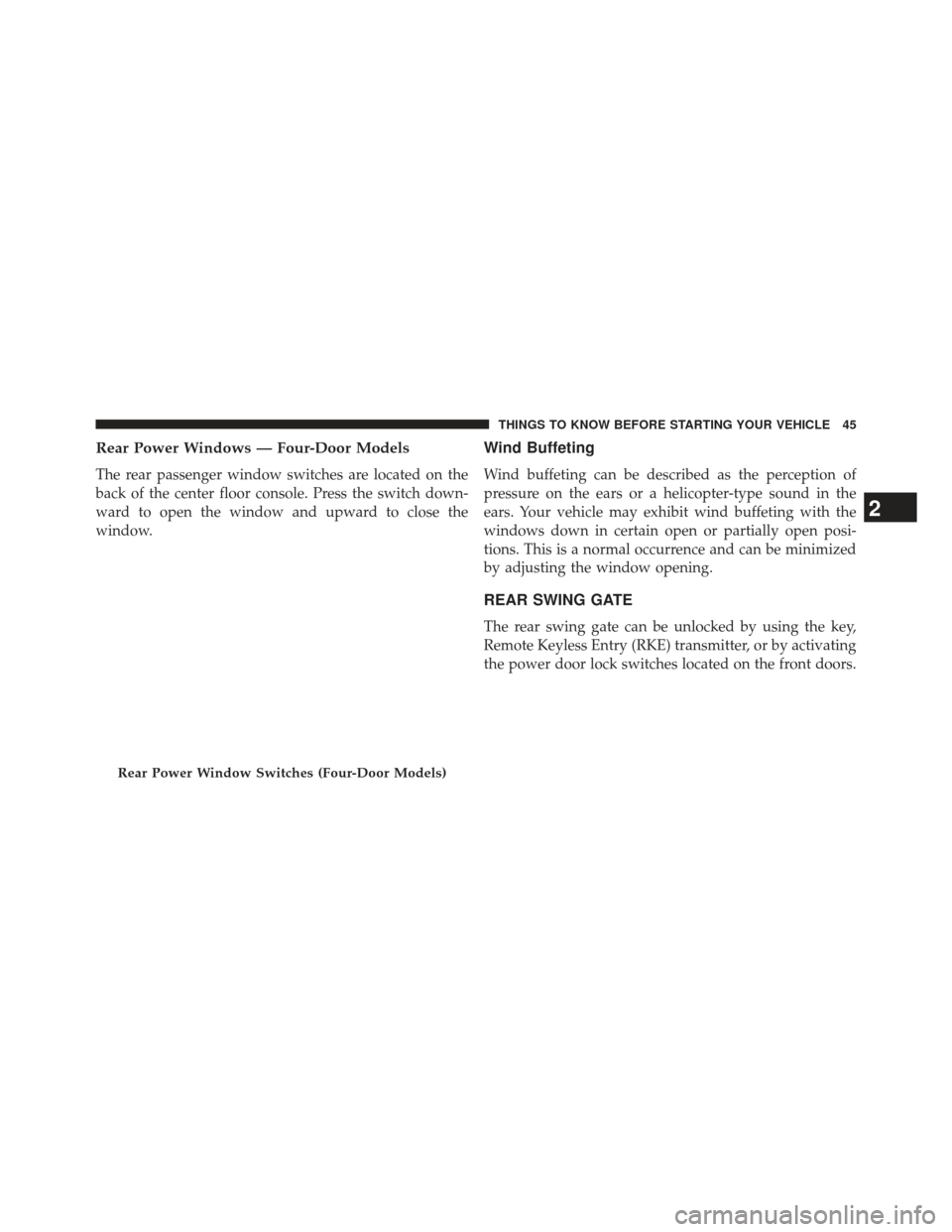
Rear Power Windows — Four-Door Models
The rear passenger window switches are located on the
back of the center floor console. Press the switch down-
ward to open the window and upward to close the
window.
Wind Buffeting
Wind buffeting can be described as the perception of
pressure on the ears or a helicopter-type sound in the
ears. Your vehicle may exhibit wind buffeting with the
windows down in certain open or partially open posi-
tions. This is a normal occurrence and can be minimized
by adjusting the window opening.
REAR SWING GATE
The rear swing gate can be unlocked by using the key,
Remote Keyless Entry (RKE) transmitter, or by activating
the power door lock switches located on the front doors.
Rear Power Window Switches (Four-Door Models)
2
THINGS TO KNOW BEFORE STARTING YOUR VEHICLE 45
Page 48 of 666
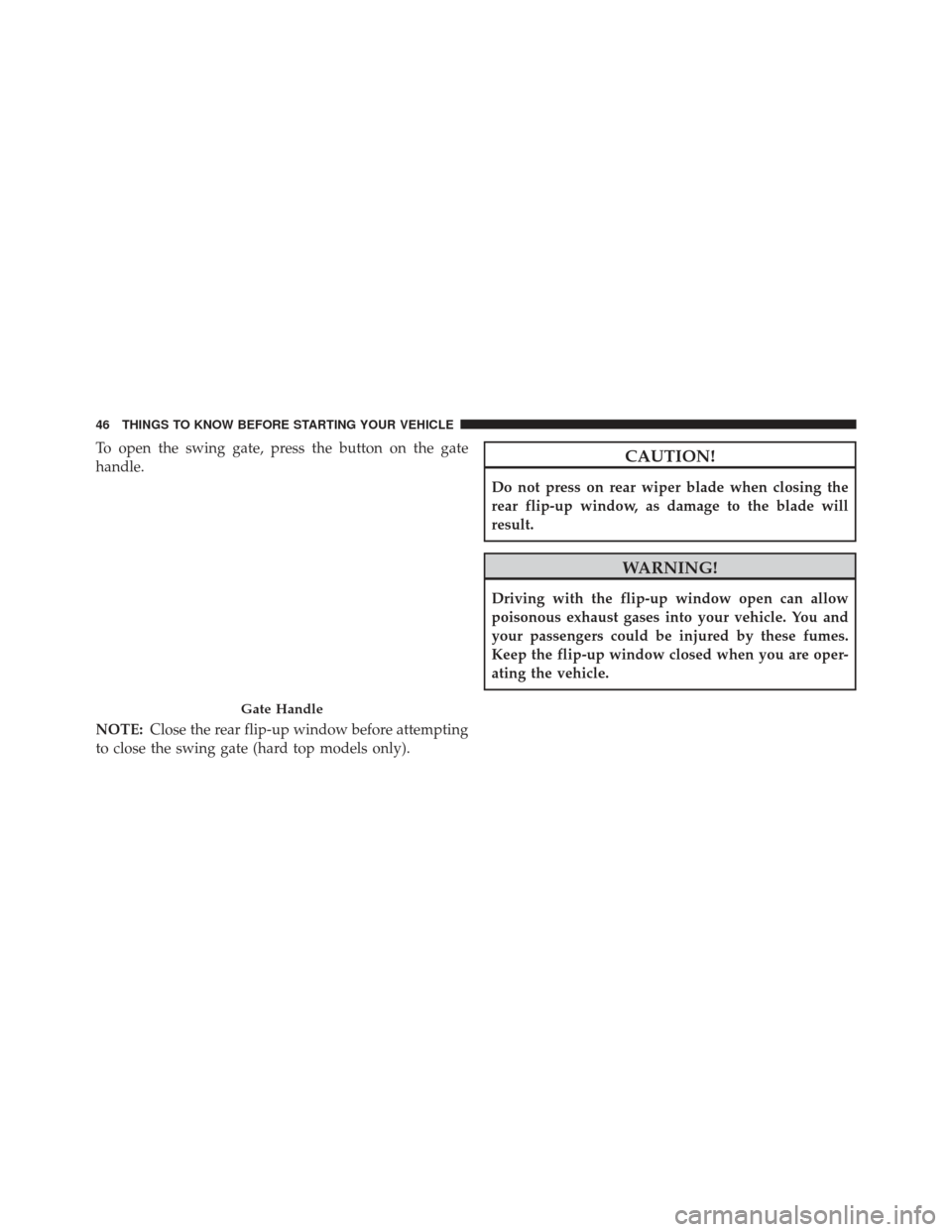
To open the swing gate, press the button on the gate
handle.
NOTE:Close the rear flip-up window before attempting
to close the swing gate (hard top models only).CAUTION!
Do not press on rear wiper blade when closing the
rear flip-up window, as damage to the blade will
result.
WARNING!
Driving with the flip-up window open can allow
poisonous exhaust gases into your vehicle. You and
your passengers could be injured by these fumes.
Keep the flip-up window closed when you are oper-
ating the vehicle.
Gate Handle
46 THINGS TO KNOW BEFORE STARTING YOUR VEHICLE
Page 49 of 666
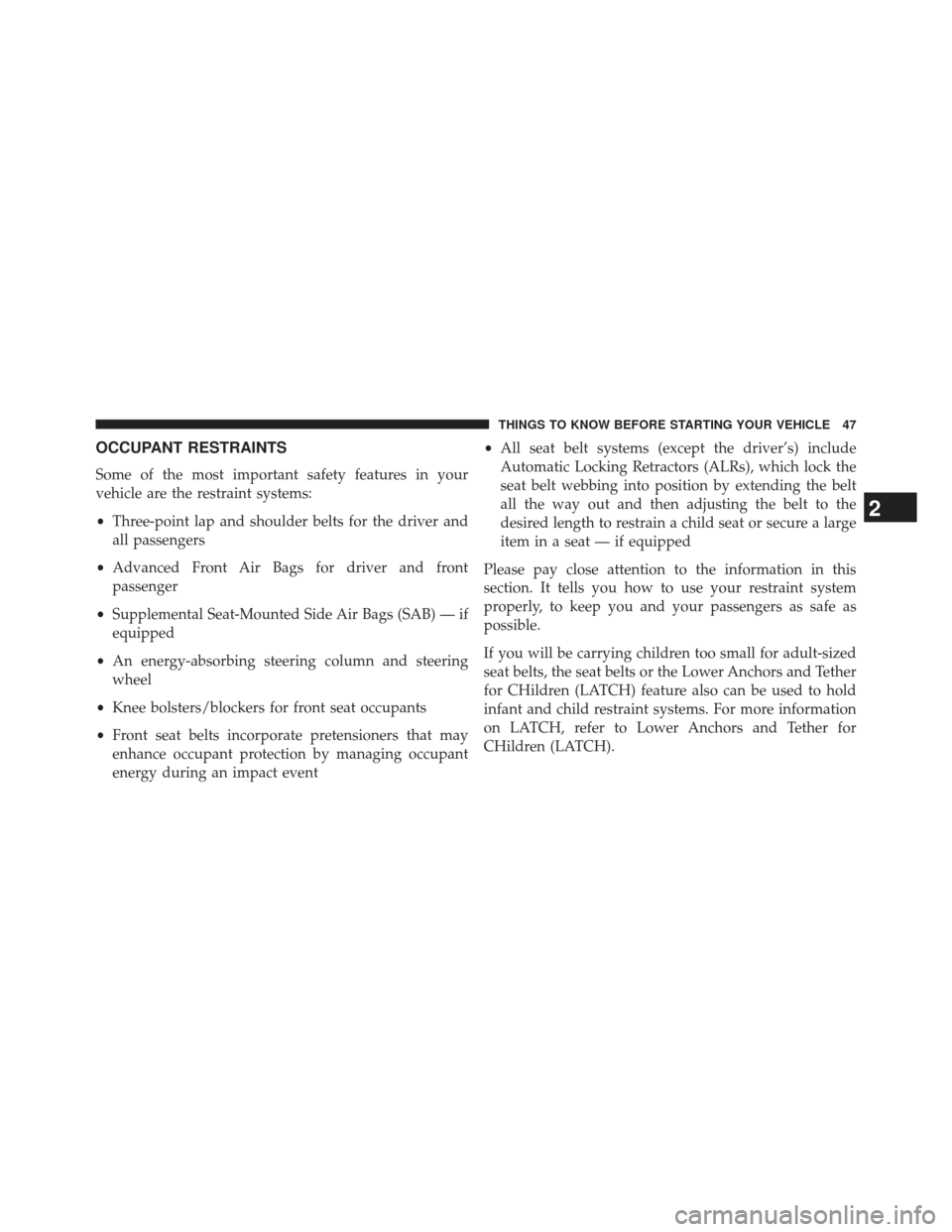
OCCUPANT RESTRAINTS
Some of the most important safety features in your
vehicle are the restraint systems:
•Three-point lap and shoulder belts for the driver and
all passengers
• Advanced Front Air Bags for driver and front
passenger
• Supplemental Seat-Mounted Side Air Bags (SAB) — if
equipped
• An energy-absorbing steering column and steering
wheel
• Knee bolsters/blockers for front seat occupants
• Front seat belts incorporate pretensioners that may
enhance occupant protection by managing occupant
energy during an impact event •
All seat belt systems (except the driver’s) include
Automatic Locking Retractors (ALRs), which lock the
seat belt webbing into position by extending the belt
all the way out and then adjusting the belt to the
desired length to restrain a child seat or secure a large
item in a seat — if equipped
Please pay close attention to the information in this
section. It tells you how to use your restraint system
properly, to keep you and your passengers as safe as
possible.
If you will be carrying children too small for adult-sized
seat belts, the seat belts or the Lower Anchors and Tether
for CHildren (LATCH) feature also can be used to hold
infant and child restraint systems. For more information
on LATCH, refer to Lower Anchors and Tether for
CHildren (LATCH).
2
THINGS TO KNOW BEFORE STARTING YOUR VEHICLE 47
Page 50 of 666
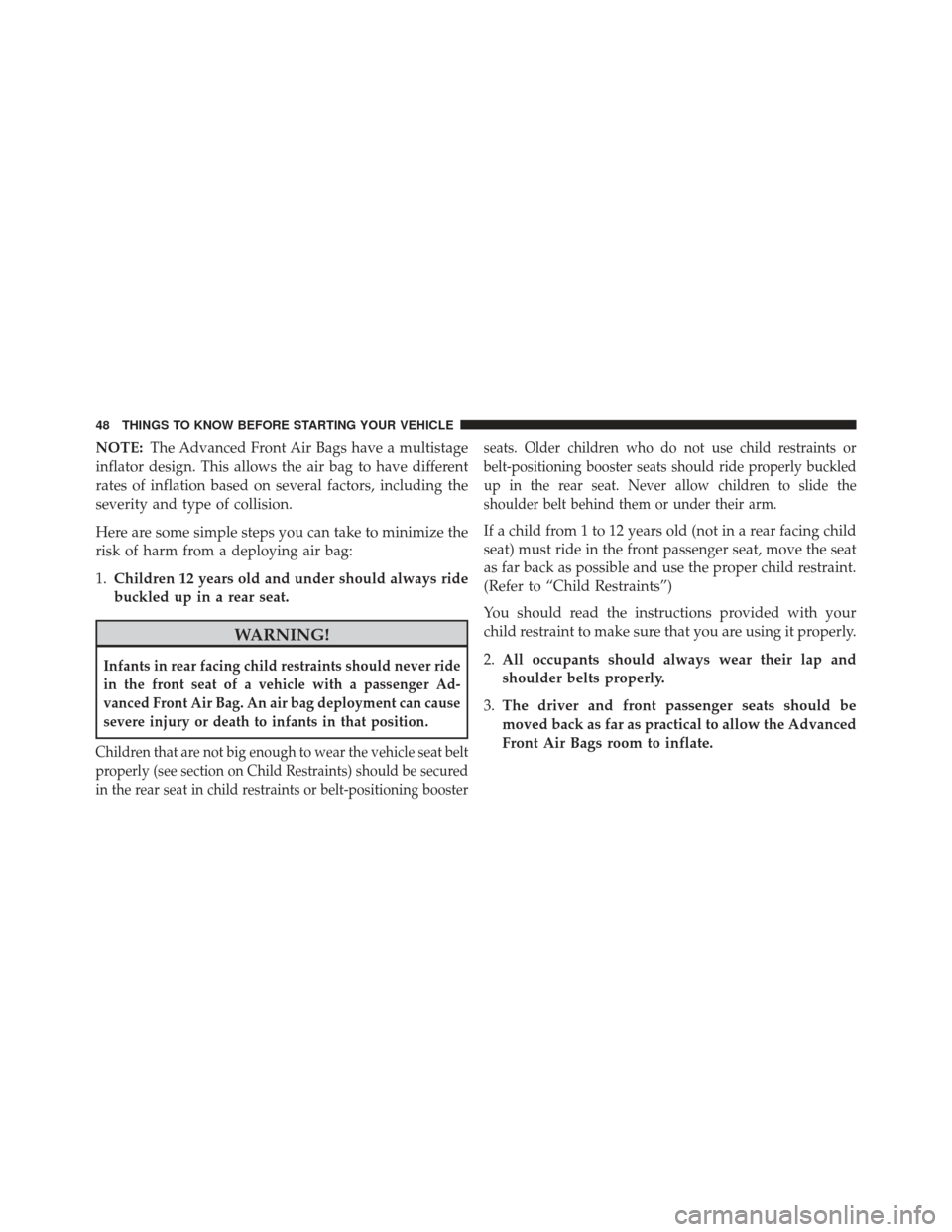
NOTE:The Advanced Front Air Bags have a multistage
inflator design. This allows the air bag to have different
rates of inflation based on several factors, including the
severity and type of collision.
Here are some simple steps you can take to minimize the
risk of harm from a deploying air bag:
1. Children 12 years old and under should always ride
buckled up in a rear seat.
WARNING!
Infants in rear facing child restraints should never ride
in the front seat of a vehicle with a passenger Ad-
vanced Front Air Bag. An air bag deployment can cause
severe injury or death to infants in that position.
Children that are not big enough to wear the vehicle seat belt
properly (see section on Child Restraints) should be secured
in the rear seat in child restraints or belt-positioning booster seats. Older children who do not use child restraints or
belt-positioning booster seats should ride properly buckled
up in the rear seat. Never allow children to slide the
shoulder belt behind them or under their arm.
If a child from 1 to 12 years old (not in a rear facing child
seat) must ride in the front passenger seat, move the seat
as far back as possible and use the proper child restraint.
(Refer to “Child Restraints”)
You should read the instructions provided with your
child restraint to make sure that you are using it properly.
2.
All occupants should always wear their lap and
shoulder belts properly.
3. The driver and front passenger seats should be
moved back as far as practical to allow the Advanced
Front Air Bags room to inflate.
48 THINGS TO KNOW BEFORE STARTING YOUR VEHICLE